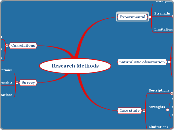Research Methods
Experimental
Description
which a researcher manipulates a variable under highly controlled conditions
Strengths
The power of the experimental method derives from the fact that it allows researchers to detect cause-and-effect relationships.
this method can be used when it is appropriate, both practically and ethically, to manipulate the variables.
Limitations
this method can only be used when it is practical and ethical for the researcher to manipulate the antecedent conditions
experimental studies are usually done in the highly controlled setting of the laboratory
Correlations
Description
is a nonexperimental, descriptive method
A correlational study is one designed to determine the degree and direction of relationship between two or more variables or measures of behavior.
Strenghts
the fact that it can be used to determine if there is a relationship between two variables without having to directly manipulate those variables
Limitations
it does not tell researchers whether or not the relationship is causal
naturalistic observation
Description
the researcher very carefully observes and records some behavior or phenomenon, sometimes over a prolonged period, in its natural setting.
Strenghts
it allows researchers to observe behavior in the setting in which it normally occurs rather than the artificial and limited setting of the laboratory
studying nature for its own sake or using nature to validate some laboratory finding or theoretical concept.
Limitations
this is a descriptive method, not an explanatory one
takes a great amount of time
the difficulty of observing behavior without disrupting it
Survey
Descriptions
non experimental, descriptive study
data collected via interviews or questionnaires
Strenghts
useful when researchers are interested in collecting data on aspects of behavior that are difficult to observe directly
Limitations
it relies on a self-report method of data collection
this method is descriptive, not explanatory
Case study
Descriptions
t involves an in-depth descriptive record, kept by an outside observer, of an individual or group of individuals.
Strenghts
seful when researchers want to get a detailed contextual view of an individual's life or of a particular phenomena.
used to help understand the social and familial factors that might be part of the development of the behaviour of an individual
useful when researchers cannot, for practical or ethical reasons, do experimental studies
Limitations
this is a descriptive method, not an explanatory one
also involve only a single individual or just a few and therefore may not be representative of the general group or population.
